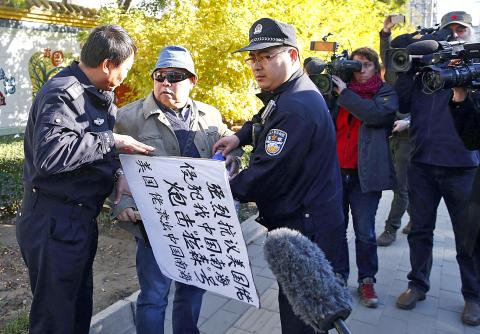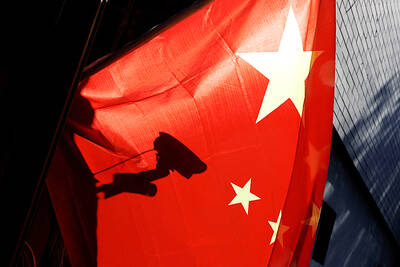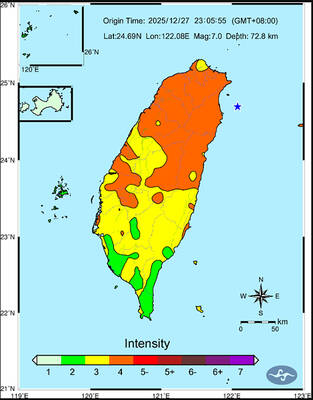The Chinese and US navies yesterday were set to hold high-level talks over tension in the South China Sea after a US warship challenged China’s territorial assertions in the disputed waters this week.
US chief of naval operations Admiral John Richardson and his Chinese counterpart, Admiral Wu Shengli (吳勝利), were to hold an hour-long video teleconference yesterday, a US official said.
A spokesman for China’s Ministry of National Defense said that Wu would present China’s “solemn position on the US vessel’s entry without permission” into waters in the Spratly Islands (Nansha Islands, 南沙群島), which Taiwan also claims.

Photo: EPA
Both officers initiated the meeting to discuss recent operations in the South China Sea and naval ties, the US official said. It will be the third video teleconference between the countries’ naval chiefs.
Beijing rebuked Washington for sending a guided-missile destroyer within 12 nautical miles (22.2km) of one of China’s artificial islands in the Spratlys on Tuesday, saying it had tracked and warned the USS Lassen and called in the US ambassador to protest.
“We would urge the US side not to continue down the wrong path,” ministry spokesman Yang Yujun (楊宇軍) told a regular briefing. “But if they do, we will take all necessary measures in accordance with the need.”
Chinese President Xi Jinping (習近平) will next week visit Vietnam, another vocal claimant in the South China Sea, and Singapore, while Chinese Minister of National Defense Chang Wanquan (常萬全) is to attend a meeting of Southeast Asian defense chiefs in Malaysia.
The patrol was the most significant US challenge yet to territorial limits China claims around its artificial islands in one of the world’s busiest sea lanes.
Separately, the English-language China Daily reported that Admiral Harry Harris, commander of US forces in the Pacific, is to visit Beijing next week. It cited an unnamed source and gave no further details.
Yang said the plan was for Harris to visit before the end of the year, and that both sides remained “in communication” about it.
A US embassy spokesman declined to comment.
Harris has been highly critical of China’s island building in the Spratlys. This year he said China was using dredges and bulldozers to create a “great wall of sand” in the South China Sea.
Meanwhile, German Chancellor Angela Merkel, who is on a two-day visit to Beijing, yesterday expressed concern over the territorial dispute and suggested China go to international courts to resolve the row.
“The territorial dispute in the South China Sea is a serious conflict. I am always a bit surprised why in this case multinational courts should not be an option for a solution,” Merkel said in a speech in Beijing.
“Nevertheless, we wish that the sea trade routes stay free and safe, because they are important for all,” she said.
Despite criticism of China’s action in the South China Sea, foreign navies from the US to Europe have sought to build ties with their Chinese counterparts.
A French frigate docked at China’s main South China Sea base in Guangdong Province on Wednesday on a four-day visit. It will participate in a maritime exercise about accidental encounters at sea.
Two Australian warships will also hold exercises with the Chinese navy in the South China Sea next week, Australian Minister of Defence Marise Payne said yesterday.

A magnitude 7.0 earthquake struck off Yilan at 11:05pm yesterday, the Central Weather Administration (CWA) said. The epicenter was located at sea, about 32.3km east of Yilan County Hall, at a depth of 72.8km, CWA data showed There were no immediate reports of damage. The intensity of the quake, which gauges the actual effect of a seismic event, measured 4 in Yilan County area on Taiwan’s seven-tier intensity scale, the data showed. It measured 4 in other parts of eastern, northern and central Taiwan as well as Tainan, and 3 in Kaohsiung and Pingtung County, and 2 in Lienchiang and Penghu counties and 1

FOREIGN INTERFERENCE: Beijing would likely intensify public opinion warfare in next year’s local elections to prevent Lai from getting re-elected, the ‘Yomiuri Shimbun’ said Internal documents from a Chinese artificial intelligence (AI) company indicated that China has been using the technology to intervene in foreign elections, including propaganda targeting Taiwan’s local elections next year and presidential elections in 2028, a Japanese newspaper reported yesterday. The Institute of National Security of Vanderbilt University obtained nearly 400 pages of documents from GoLaxy, a company with ties to the Chinese government, and found evidence that it had apparently deployed sophisticated, AI-driven propaganda campaigns in Hong Kong and Taiwan to shape public opinion, the Yomiuri Shimbun reported. GoLaxy provides insights, situation analysis and public opinion-shaping technology by conducting network surveillance

‘POLITICAL GAME’: DPP lawmakers said the motion would not meet the legislative threshold needed, and accused the KMT and the TPP of trivializing the Constitution The Legislative Yuan yesterday approved a motion to initiate impeachment proceedings against President William Lai (賴清德), saying he had undermined Taiwan’s constitutional order and democracy. The motion was approved 61-50 by lawmakers from the main opposition Chinese Nationalist Party (KMT) and the smaller Taiwan People’s Party (TPP), who together hold a legislative majority. Under the motion, a roll call vote for impeachment would be held on May 19 next year, after various hearings are held and Lai is given the chance to defend himself. The move came after Lai on Monday last week did not promulgate an amendment passed by the legislature that

AFTERMATH: The Taipei City Government said it received 39 minor incident reports including gas leaks, water leaks and outages, and a damaged traffic signal A magnitude 7.0 earthquake struck off Taiwan’s northeastern coast late on Saturday, producing only two major aftershocks as of yesterday noon, the Central Weather Administration (CWA) said. The limited aftershocks contrast with last year’s major earthquake in Hualien County, as Saturday’s earthquake occurred at a greater depth in a subduction zone. Saturday’s earthquake struck at 11:05pm, with its hypocenter about 32.3km east of Yilan County Hall, at a depth of 72.8km. Shaking was felt in 17 administrative regions north of Tainan and in eastern Taiwan, reaching intensity level 4 on Taiwan’s seven-tier seismic scale, the CWA said. In Hualien, the